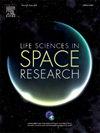低剂量(10 cGy)质子暴露后雄性大鼠的移位处理速度降低
IF 2.8
3区 生物学
Q2 ASTRONOMY & ASTROPHYSICS
引用次数: 0
摘要
空间辐射暴露具有重大的生物医学风险,包括对中枢神经系统的影响。这些风险与长期太空任务期间的认知功能特别相关。一项关键的认知技能是决策,这需要注意力集中转移(ATSET)——快速评估问题、评估选项并选择最佳行动的能力。先前的研究表明,暴露于10 cGy的锶离子会损害动物模型的ATSET性能。然而,低LET (<;1 keV/μm)质子对宇航员在航天器内遇到的总辐射通量有很大影响,但对ATSET性能的影响尚不清楚。为了解决这一空白,我们评估了100 MeV/n质子(LET = 0.732 keV/μm)的10 cGy颅脑照射对雄性Sprague-Dawley大鼠ATSET性能的影响。我们还调查了是否同时暴露于可变重力(超重力升压,降压,据称与暴露于微重力(另一个主要的太空飞行压力源)具有相同的效果,加剧sr诱导的认知缺陷。我们的研究结果表明,质子暴露会显著损害ATSET的性能,在进行复合识别逆转和额外维度转移时,处理速度会下降。值得注意的是,当超重力与质子暴露相结合时,没有观察到加性或协同效应。低剂量质子暴露对中枢神经系统功能的影响,特别是在复杂任务中降低处理速度的影响,值得进一步研究。如果暴露在银河宇宙射线下的宇航员也出现类似的认知缺陷,那么任务的成功和安全可能会受到严重影响。本文章由计算机程序翻译,如有差异,请以英文原文为准。
Reduced set-shifting processing speed in male rats following low dose (10 cGy) proton exposure
Space radiation (SR) exposure poses significant biomedical risks, including effects on the central nervous system (CNS). These risks are particularly relevant to cognitive function during long-duration space missions. One critical cognitive skill is decision-making, which requires attentional set-shifting (ATSET)—the ability to quickly assess problems, evaluate options, and select the best actions. Previous studies have shown that exposure to <10 cGy of SR ions impairs ATSET performance in animal models. However, the impact of low LET (< 1 keV/μm) protons, which significantly contribute to the total radiation flux astronauts encounter within spacecraft, on ATSET performance is unknown.
To address this gap, we evaluated the effects of cranial irradiation with 10 cGy of 100 MeV/n protons (LET = 0.732 keV/μm) on ATSET performance in male Sprague-Dawley rats. We also investigated whether concurrent exposure to variable gravity (hypergravity step-up, step down, purported to have the same effect as exposure to microgravity (another major spaceflight stressor) exacerbated SR-induced cognitive deficits. Our findings indicate that proton exposure alone significantly impaired ATSET performance, as evidenced by decreased processing speed while performing compound discrimination reversal and extra-dimensional shifting. Notably, no additive or synergistic effects were observed when hypergravity was combined with proton exposure.
The impact that low-dose proton exposure has on CNS functionality, particularly in reducing processing speed during complex tasks, warrant further investigation. If similar cognitive deficits were to occur in astronauts exposed to galactic cosmic rays, mission success and safety could be significantly compromised.
求助全文
通过发布文献求助,成功后即可免费获取论文全文。
去求助
来源期刊

Life Sciences in Space Research
Agricultural and Biological Sciences-Agricultural and Biological Sciences (miscellaneous)
CiteScore
5.30
自引率
8.00%
发文量
69
期刊介绍:
Life Sciences in Space Research publishes high quality original research and review articles in areas previously covered by the Life Sciences section of COSPAR''s other society journal Advances in Space Research.
Life Sciences in Space Research features an editorial team of top scientists in the space radiation field and guarantees a fast turnaround time from submission to editorial decision.
 求助内容:
求助内容: 应助结果提醒方式:
应助结果提醒方式:


